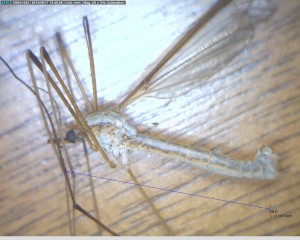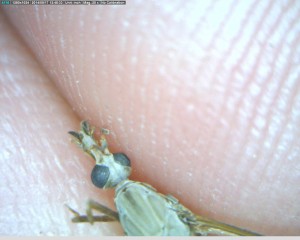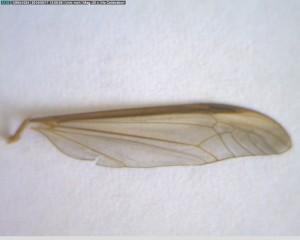It appears that exotic crane flies have invaded a new territory area in North America. I received a sample for identification from Adam Van Dyke of Professional Turfgrass Solutions based out of West Jordan, Utah. Adam is a consultant extradordinaire, who scouts a lot of turf and conducts research trials. He has observed leatherjackets (larvae of crane flies) in the past damaging putting green turf. This time he was fortunate enough this time to collect some adults flying across the turf. The specimens that were sent to me were identified as Tipula oleracea, the common crane fly.
Crane flies are relatively large mosquito-looking (emphasis on looking) Dipterans that are present across the globe. There are literally thousand species of crane flies worldwide and several harmless, non-turf damaging species that can be found in many turf situations. Two species of European crane flies are present in North America that will actually damage turfgrass by feeding above and below ground on plant parts. Additionally, many vertebrate predators (birds, skunks, raccoons) will often cause secondary turf damage when they tear up the turf looking for a tasty treat.
The common crane fly (Tipula oleracea) can be found in its native distribution from southern Europe to northern Africa. Tipula paludosa, commonly referred to as the European crane fly, can be found in northern Europe. Both the species occur in similar geographic regions in North America, with extremely large and damaging populations on the east (Ontario to Upstate NY) and west coasts (British Columbia to northern California).
Though Utah is a long way from State College, this tale can benefit turfgrass managers on this coast. I spoke with Rod Ferrentino, the east coast version of Adam this afternoon. He reports that masses of crane flies are currently flying in upstate NY. The common crane fly has two generations per year. Adults can be seen flying over the turf in the spring (late April, early May) and again in the fall (August, September) in the east. The European crane fly emerges as an adult only in the fall, and thus both species can be seen around this time.
If you suspect that you have crane flies, it is important to try to get a positive identification. There are many ways to collect adults. The easiest way is to use an insect net, but often a hat will do if they are dense enough. Many superintendents have collected crane flies off of screen doors or white painted maintenance buildings. If you can get an adult, place it in a small plastic container or test tube and send it along. We would be happy to take a look (mail to: B. McGraw, Penn State Univ., 243 ASI Building, State College, PA, 16802).
As an aside: Matt Petersen of Roanoke University wrote an excellent paper on the potential spread of both species of crane flies in North America in the journal of Biological Invasions (reading not for the faint of heart). His computer models actually predicted that this species could potentially spread to Utah. Well done Matt!



